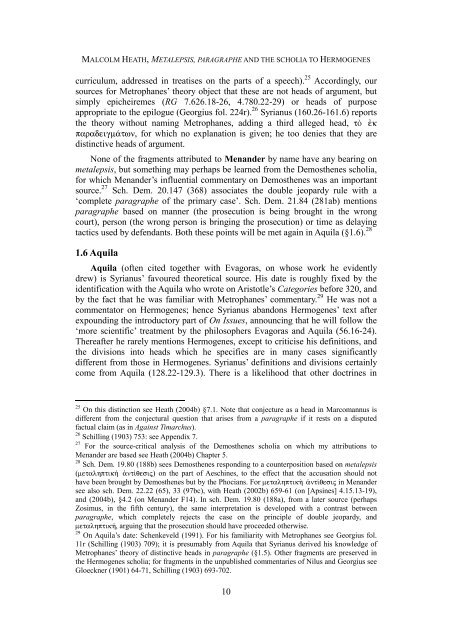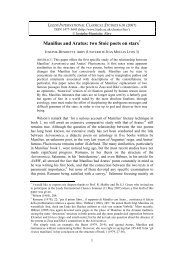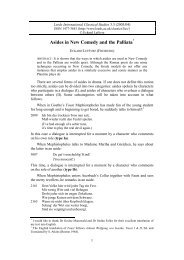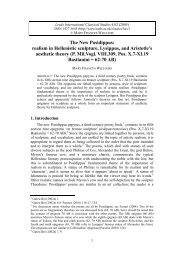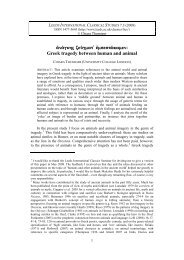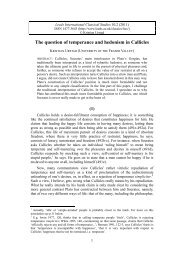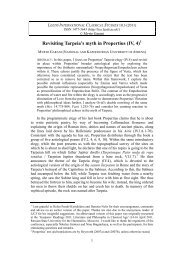Metalepsis, paragraphe and the scholia to Hermogenes - Leeds ...
Metalepsis, paragraphe and the scholia to Hermogenes - Leeds ...
Metalepsis, paragraphe and the scholia to Hermogenes - Leeds ...
You also want an ePaper? Increase the reach of your titles
YUMPU automatically turns print PDFs into web optimized ePapers that Google loves.
MALCOLM HEATH, METALEPSIS, PARAGRAPHE AND THE SCHOLIA TO HERMOGENES<br />
curriculum, addressed in treatises on <strong>the</strong> parts of a speech). 25 Accordingly, our<br />
sources for Metrophanes’ <strong>the</strong>ory object that <strong>the</strong>se are not heads of argument, but<br />
simply epicheiremes (RG 7.626.18-26, 4.780.22-29) or heads of purpose<br />
appropriate <strong>to</strong> <strong>the</strong> epilogue (Georgius fol. 224r). 26 Syrianus (160.26-161.6) reports<br />
<strong>the</strong> <strong>the</strong>ory without naming Metrophanes, adding a third alleged head, tÕ k<br />
paradeigm£twn, for which no explanation is given; he <strong>to</strong>o denies that <strong>the</strong>y are<br />
distinctive heads of argument.<br />
None of <strong>the</strong> fragments attributed <strong>to</strong> Men<strong>and</strong>er by name have any bearing on<br />
metalepsis, but something may perhaps be learned from <strong>the</strong> Demos<strong>the</strong>nes <strong>scholia</strong>,<br />
for which Men<strong>and</strong>er’s influential commentary on Demos<strong>the</strong>nes was an important<br />
source. 27 Sch. Dem. 20.147 (368) associates <strong>the</strong> double jeopardy rule with a<br />
‘complete <strong>paragraphe</strong> of <strong>the</strong> primary case’. Sch. Dem. 21.84 (281ab) mentions<br />
<strong>paragraphe</strong> based on manner (<strong>the</strong> prosecution is being brought in <strong>the</strong> wrong<br />
court), person (<strong>the</strong> wrong person is bringing <strong>the</strong> prosecution) or time as delaying<br />
tactics used by defendants. Both <strong>the</strong>se points will be met again in Aquila (§1.6). 28<br />
1.6 Aquila<br />
Aquila (often cited <strong>to</strong>ge<strong>the</strong>r with Evagoras, on whose work he evidently<br />
drew) is Syrianus’ favoured <strong>the</strong>oretical source. His date is roughly fixed by <strong>the</strong><br />
identification with <strong>the</strong> Aquila who wrote on Aris<strong>to</strong>tle’s Categories before 320, <strong>and</strong><br />
by <strong>the</strong> fact that he was familiar with Metrophanes’ commentary. 29 He was not a<br />
commenta<strong>to</strong>r on <strong>Hermogenes</strong>; hence Syrianus ab<strong>and</strong>ons <strong>Hermogenes</strong>’ text after<br />
expounding <strong>the</strong> introduc<strong>to</strong>ry part of On Issues, announcing that he will follow <strong>the</strong><br />
‘more scientific’ treatment by <strong>the</strong> philosophers Evagoras <strong>and</strong> Aquila (56.16-24).<br />
Thereafter he rarely mentions <strong>Hermogenes</strong>, except <strong>to</strong> criticise his definitions, <strong>and</strong><br />
<strong>the</strong> divisions in<strong>to</strong> heads which he specifies are in many cases significantly<br />
different from those in <strong>Hermogenes</strong>. Syrianus’ definitions <strong>and</strong> divisions certainly<br />
come from Aquila (128.22-129.3). There is a likelihood that o<strong>the</strong>r doctrines in<br />
25 On this distinction see Heath (2004b) §7.1. Note that conjecture as a head in Marcomannus is<br />
different from <strong>the</strong> conjectural question that arises from a <strong>paragraphe</strong> if it rests on a disputed<br />
factual claim (as in Against Timarchus).<br />
26 Schilling (1903) 753: see Appendix 7.<br />
27 For <strong>the</strong> source-critical analysis of <strong>the</strong> Demos<strong>the</strong>nes <strong>scholia</strong> on which my attributions <strong>to</strong><br />
Men<strong>and</strong>er are based see Heath (2004b) Chapter 5.<br />
28 Sch. Dem. 19.80 (188b) sees Demos<strong>the</strong>nes responding <strong>to</strong> a counterposition based on metalepsis<br />
(metalhptik¾ ¢nt…qesij) on <strong>the</strong> part of Aeschines, <strong>to</strong> <strong>the</strong> effect that <strong>the</strong> accusation should not<br />
have been brought by Demos<strong>the</strong>nes but by <strong>the</strong> Phocians. For metalhptik¾ ¢nt…qesij in Men<strong>and</strong>er<br />
see also sch. Dem. 22.22 (65), 33 (97bc), with Heath (2002b) 659-61 (on [Apsines] 4.15.13-19),<br />
<strong>and</strong> (2004b), §4.2 (on Men<strong>and</strong>er F14). In sch. Dem. 19.80 (188a), from a later source (perhaps<br />
Zosimus, in <strong>the</strong> fifth century), <strong>the</strong> same interpretation is developed with a contrast between<br />
<strong>paragraphe</strong>, which completely rejects <strong>the</strong> case on <strong>the</strong> principle of double jeopardy, <strong>and</strong><br />
metalhptik», arguing that <strong>the</strong> prosecution should have proceeded o<strong>the</strong>rwise.<br />
29 On Aquila’s date: Schenkeveld (1991). For his familiarity with Metrophanes see Georgius fol.<br />
11r (Schilling (1903) 709); it is presumably from Aquila that Syrianus derived his knowledge of<br />
Metrophanes’ <strong>the</strong>ory of distinctive heads in <strong>paragraphe</strong> (§1.5). O<strong>the</strong>r fragments are preserved in<br />
<strong>the</strong> <strong>Hermogenes</strong> <strong>scholia</strong>; for fragments in <strong>the</strong> unpublished commentaries of Nilus <strong>and</strong> Georgius see<br />
Gloeckner (1901) 64-71, Schilling (1903) 693-702.<br />
10


